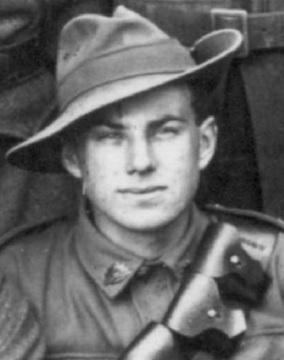CURNOW, Rupert Colman
| Service Number: | 3468 |
|---|---|
| Enlisted: | 5 January 1917, Melbourne, Victoria |
| Last Rank: | Private |
| Last Unit: | 8th Light Horse Regiment |
| Born: | Ballarat, Victoria, 31 October 1898 |
| Home Town: | Mentone, Kingston, Victoria |
| Schooling: | Not yet discovered |
| Occupation: | Student (medicine) |
| Died: | Natural Causes, Heidelberg, Victoria, 18 December 1950, aged 52 years |
| Cemetery: |
Warringal Cemetery, Victoria Heidelberg, Victoria, Australia |
| Memorials: | Mentone St. Augustine's Anglican Church Memorial Window |
World War 1 Service
| 5 Jan 1917: | Enlisted AIF WW1, Melbourne, Victoria | |
|---|---|---|
| 2 Nov 1917: |
Involvement
AIF WW1, Private, 3468, 8th Light Horse Regiment, Enlistment/Embarkation WW1, --- :embarkation_roll: roll_number: '2' embarkation_place: Melbourne embarkation_ship: HMAT Commonwealth embarkation_ship_number: A73 public_note: '' |
|
| 2 Nov 1917: | Embarked AIF WW1, Private, 3468, 8th Light Horse Regiment, HMAT Commonwealth, Melbourne |
Rupert Curnow
Rupert Coleman Curnow was born on 30 October 1898 at Ballarat VIC. At the time of his birth his father, Josiah (1856-1942) was 42, and his mother Florence(1873-1929) was 25. Rupert was an only child. He was initially educated at a Ballarat Primary school then later at Ballarat Grammar School. In 1916 he enrolled at Melbourne University and had started a degree in Medicine.
When Rupert enlisted he was a single, 18-year-old University student living in Melbourne. His enlistment records state that he was 5 foot 10 inches tall ( cm) and weighed 140 lbs ( kg). His complexion was fresh, his eyes were blue, and his hair brown. Rupert's previous militia service included 3 years in the cadets and 6 months with the Melbourne University Rifles. His religious denomination was given as the Church of England.
An interesting note in his service records indicates that his parents had provided conditional consent to enlisting and that he was not to embark on overseas service until he attained the age of 19. The O.C (Officer Commanding) of the 3rd Military District included a further note stating that he is to go to the Light Horse, providing he passed the riding test. Rupert clearly did pass the test as he was taken on strength with the 30th reinforcements of the 8th Light Horse Regiment on 5 January 1917, However, he did not embark until 1 November 1917, therefore, satisfying his parent's conditional consent.
Rupert embarked on HMAT A73 Commonwealth at Melbourne, Victoria, and joined the EEF (Egyptian Expeditionary Forces) at Moascar on 10 December 1917. Upon arriving he was shortly admitted to the hospital suffering from bronchitis.
Rupert was wounded in the Jordan Valley and spent some time in a military hospital in Jerusalem. On being discharged, he returned to his unit to take part in the advance to Damascus, and later Aleppo. He was promoted to Corporal in late 1917 and became part of the force that remained in Palestine until late 1919.
On 8 July 1919 Rupert embarked on the SS Malta for a return to Australia. For his service, during the war, he was awarded the British War Medal and the Victory Medal.
Upon returning to Australia, Rupert decided against continuing his studies in medicine and instead applied for land under the Soldier Settlement Scheme. In August 1922 he was granted 400 acres at Biggara, east of Corryong.
Submitted 29 September 2021 by Stephen Learmonth
Biography
"Ivanhoe M.L.A. Dies After Long Illness
Mr. Rupert Colman Curnow, L.C.P. member for Ivanhoe in the Legislative Assembly since 1947, died yesterday at Heidelberg Repatriation Hospital after an illness lasting more than 12 months. He entered Victorian politics when he defeated Mr. R. A. Gardner, the Independent member. Born at Ballarat in 1898, Mr. Curnow studied medicine until he enlisted on his 18th birthday. Joining the 8th Light Horse, he served in the Middle East and Palestine, and later with the Camel Corps. He returned to Australia wounded, and took up a soldier settlement block at Corryong, in north-eastern Victoria. An original member of the Corryong branch of the R.S.L. he later was member of the R.S.L. State Council for 15 years, and a vice-president in 1946. In the last war, he joined the Navy department, and was seconded to the State Repatriation Board on which he served until 1946.
R.S.L. Work
In his R.S.L. work, Mr. Curnow served on the Soldiers' Pension Board, and the Returned Soldiers' Children's Education Board. Mr. Curnow leaves a wife, a son and a daughter. The Premier (Mr. McDonald), expressing the Government's regret, said Mr. Curnow had been most conscientious, and made firm friends in all parties. The Labor party leader (Mr. Cain) also paid tribute to Mr. Curnow's diligent attention to his duties. The Leader of the L.C.P. (Mr. Hollway) said that Mr. Curnow was one of the hardest workers in Parliament. He paid special tribute to Mrs. Curnow for carrying the burden of her husband's electorate work in recent months." - from the Melbourne Age 19 Dec 1952 (nla.gov.au)











